Ytterbium-Doped Fiber Amplifiers (YDFA), 1 µm
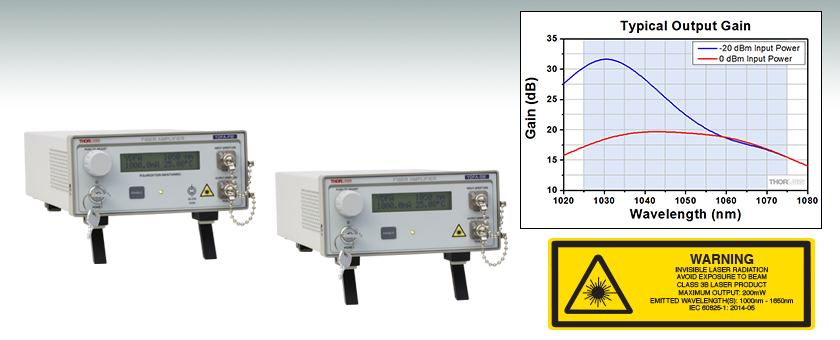
- Saturation Output Power of >20 dBm
- Broad 1025 - 1075 nm Operating Range
- Optimized for Ultrafast Pulse Amplification
- Simple, Turnkey Operation
YDFA100P
Polarization-Maintaining YDFA
YDFA100S
Single Mode YDFA

Please Wait
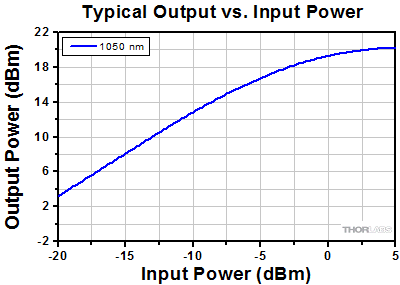
Click to Enlarge
This plot gives the output power as a function of input power for our polarization-maintaining YDFAs. A complete set of performance graphs is available on the Graphs tab.
Features
- Operating Wavelength Range: 1025 - 1075 nm
- >22 dB Small Signal Gain and 20 dBm Typical Output Power (See Graphs Tab for Values Over Wavelength Range)
- Ideal for Use as a Preamplifier for Ultrafast and CW Applications
- Single Mode or Polarization-Maintaining Versions Available
- Front Panel Controls and Remote Control over USB
Thorlabs' Core-Pumped Ytterbium-Doped Fiber Amplifiers (YDFAs) offer 20 dBm (100 mW) typical output power with a low noise figure of <8 dB. Each is enclosed in a compact, turnkey benchtop package with FC/APC input and output connectors. In order to support applications involving femtosecond pulses, they are engineered to impart minimal dispersion. Each YDFA includes built-in input and output isolators to minimize back reflections to the amplifier and light source. Custom amplifiers with higher output power and gain is also available upon request; please contact techsupport@thorlabs.com with inquiries.
Versions for single mode or polarization-maintaining operation are available. The YDFA100S uses HI1060 single mode fiber with <0.3 dB polarization-dependent gain. The YDFA100P is a polarization-maintaining amplifier with input and output isolators that block light polarized along the fast axis of the PM980-XP fiber. Therefore, the YDFA100P is designed to work with input signals polarized along the slow axis of the fiber. Output light from the amplifier has a polarization extinction ratio of >20 dB. The input and output fiber connector keys are aligned to the slow axis of the fiber.
The pump current of the ytterbium-doped fiber amplifier is adjustable through the instrument's front panel, allowing the user to vary the gain and output power of the amplifier. In addition, remote control of the pump current is supported by sending serial commands via a USB 2.0 connector. For added safety, the user may connect an interlock circuit to the 2.5 mm mono jack on the rear panel.
Each YDFA uses a universal power supply allowing operation over 100 - 240 VAC, 50 - 60 Hz without the need to select the line voltage. A region-specific power cord is included.
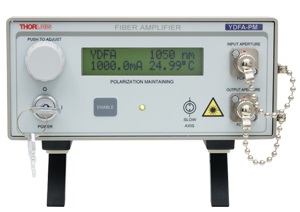
Click to Enlarge
YDFA100P Front Panel
The front panel of the YDFAs include a digital display, a rotating knob that adjusts the pump laser current, a key switch, and an amplifier enable switch button paired with a green LED.

Click to Enlarge
YDFA100P Back Panel
The back panel of the YDFAs include a USB type B connector for remote operation and a 2.5 mm mono jack for a user-designed interlock circuit.
Unless otherwise indicated, all values are specified for a CW input beam at 1050 nm.
| Item # | YDFA100S | YDFA100P |
|---|---|---|
| Amplifier Specifications | ||
| Operating Wavelength Range | 1025 - 1075 nm | |
| Output Power (@ 3 dBm Input Power)a | 19 dBm (Min) 20 dBm (Typical) |
|
| Small Signal Gain (@ -20 dBm Input Power)a | >22 dB | |
| Noise Figurea | <8 dB | |
| Output Power Stability (@ 3 dBm Input Power) |
<±2% Over 24 Hours(After 15 Minute Warm-Up, for Ambient Temperature ±2 °C) | |
| Total Absolute Dispersion within Amplifier | <0.2 ps/nm | |
| Laser Class | 3B | |
| Fiber Specifications | ||
| Output Polarization | Random | Linear Aligned to Slow Axis |
| Polarization Extinction Ratio | N/A | >20 dB |
| Polarization-Dependent Gain | <0.3 dB | N/A |
| Return Loss at Input Port | >50 dB | |
| Input / Output Isolation | >20 dB | |
| Input / Output Fiber Type | HI1060 | PM980-XP |
| Input / Output Fiber Connectors | FC/APC Compatible, 2.0 mm Narrow Key | |
| Absolute Maximum Ratings | |
|---|---|
| Absolute Maximum Input Power | 10 dBm |
| Absolute Maximum Output Power | 23 dBm |
| Operating Temperature | 15 to 35 °C |
| Storage Temperature | 0 to 50 °C |
| General Specifications | |
|---|---|
| Input Voltage | 100 - 240 VAC, 50 - 60 Hz |
| Input Power | 20 VA (Max) |
| Fuse Rating | 500 mA |
| Fuse Type | IEC60127-2/III (250 VA, Slow Blow Type "T") |
| Dimensions (W x H x D) | 5.77" x 3.07" x 12.17" (146.5 mm x 77.9 mm x 309.1 mm) |
| Weight | 1.96 kg (4.32 lbs) |
| Connections and Controls | |
| Interface Control | Optical Encoder with Push Button |
| Enable Select | Keypad Switch Enable with LED Indicator |
| Power On | Key Switch |
| Fiber Connectors | FC/APC Compatible, 2.0 mm Narrow Key |
| Input Power Connector | IEC Connector |
| Interlock | 2.5 mm Mono Jack |
| Communications | |
| Communications Port | USB 2.0 Compatible |
| COM Connection | USB Type B Connector |
| Required Cable | USB Type A to Type B Cable (Replacement Item # USB-A-79) |
Performance Graphs
Unless otherwise stated, all performance graphs below were obtained using a CW input, the maximum pump current of 1000 mA, and the factory pump temperature setting of 25 °C. Performance may vary from unit to unit; this data reflects the typical performance of our YDFAs, and is presented for reference only. The guaranteed specifications are shown in the Specs tab.
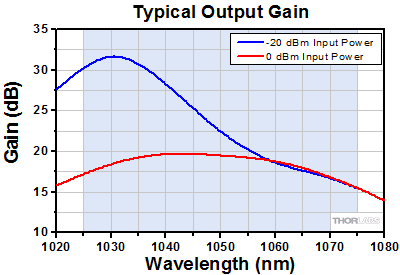
Click to Enlarge
Click for Raw Data
The typical gain as a function of the wavelength. The blue-shaded region denotes the specified operating wavelength range.

Click to Enlarge
Click for Raw Data
The typical noise figure as a function of the wavelength. The blue-shaded region denotes the specified operating wavelength range.
| Simulation Model Parameters (Using the YDFA100P) | |||
|---|---|---|---|
| Input | |||
| Pulse Width | 50 fs | 100 fs | 200 fs |
| Pulse Energy | 26 pJ | ||
| Peak Power | >450 W | >240 W | >120 W |
| Output | |||
| Pulse Width | 3.8 ps | 3.3 ps | 2.7 ps |
| Peak Power | >300 W | >350 W | >400 W |
| Output with Compression | |||
| Pulse Width | 103 fs | 120 fs | 145 fs |
| Peak Power | >10 kW | >8 kW | >6 kW |
Femtosecond Pulse Amplification
Ultrafast pulses amplified by a YDFA will experience some pulse broadening due to dispersion effects. This dispersion is a natural consequence of light moving through the doped gain fiber and other fiber components and cannot be eliminated completely. Thorlabs' YDFA amplifiers optimize the gain fiber length to minimize dispersion and nonlinearity while maximizing the amplification gain. After amplification, the pulse can be compressed to attain a pulse width closer to the input pulse. The fibers used in the YDFA100P and YDFA100S have identical dispersion and nonlinearity and thus can both be used in femtosecond applications.
Simulated results of amplification for three different input pulses through the YDFA100P amplifier are shown in the graphs below and the table to the right. The input pulses are specified at 1045 nm and 26 pJ pulse energy, and with a 50 fs, 100 fs, or 200 fs pulse width. The YDFA amplifier simulations set the gain at 1045 nm to 17.1 dB and use the measured gain spectral shape in calculating the amplified pulse. In addition, the YDFA is modeled with 1 m of polarization-maintaining fiber before and after the amplifier. Finally, the results below also show simulated pulse compression of the post-amplification pulse using a pair of 1200 lines/mm diffraction gratings. Optical loss in the grating pair has been neglected for the calculation of the peak power values shown in the table.
Experimental Validation of YDFA100P Amplification
This experiment combines measurement of an amplified pulse in the YDFA100P with numerical simulation of the expected output pulse. A 117 fs input pulse was generated using a 100 MHz oscillator. The YDFA100P was used to amplify the pulse from a 2.6 mW average power to 140 mW, and then the output pulses were compressed using an external pulse compressor. The input and output pulse intensity profiles were characterized using frequency-resolved optical gating (FROG) measurements.
The results shown below indicate that the amplified pulses were compressible to their original width due to the low nonlinearity and third-order dispersion effects in the YDFA. Simulations of the input and output pulse using the model discussed above are also shown alongside the experimental data and show relative agreement with the experimental results. The fibers used in the YDFA100P and YDFA100S have identical dispersion and nonlinearity and thus can both be used in femtosecond applications.
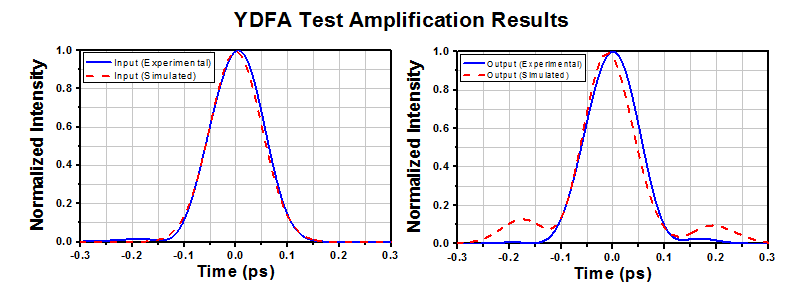
Click to Enlarge
Experimental and numerically simulated pulses before amplification and after with pulse compression are shown. Experimental data is provided courtesy of Tong Zhou and Russel Wilcox at Lawrence Berkeley National Laboratory.
Amplifier Comparison
Fiber amplifiers such as EDFAs and YDFAs are typically better suited than semiconductor optical amplifiers (e.g., BOAs and SOAs) for amplifying femtosecond laser pulses. These amplifier types differ in their saturation energies, their gain saturation dynamics, and their free carrier lifetimes. In semiconductor amplifiers, the saturation energies are relatively low, on the order of a few picojoules. This limits the amplified pulse energy that can be achieved by semiconductor amplifiers. By way of comparison, in fiber amplifiers, the saturation energies exceed microjoule levels. Additionally, the gain recovery times in semiconductor amplifiers are governed by the carrier lifetime, which is in the 10 ps to 100 ps timescale. The carrier lifetime of fiber amplifiers is typically in the 10 µs to 1 ms timescale.
Consider the case of a mode-locked femtosecond laser with a repetition rate on the order of 1 MHz. For pulse energies well below the saturation energy of the semiconductor amplifiers, the pulses will be amplified with minimal distortion. However, once the pulse energy exceeds the saturation energy, the amplification will saturate during the pulse, leading to a gain difference over the pulse's temporal profile and distorting the pulse shape. Since fiber amplifiers have higher saturation energies than semiconductor amplifiers, they are less prone to experience gain saturation by this mechanism.
Because the gain recovery time of a semiconductor amplifier (10 ps to 100 ps timescale) is shorter than the repetition period, the gain medium recovers before the next pulse in the pulse train arrives at the semiconductor amplifier. Therefore the same process is repeated for each pulse. In fiber amplifiers, the free carrier lifetime (10 µs to 1 ms timescale) is much longer than the repetition period. Consequently, fiber amplifiers can be thought of as responding to the pulse's average power, as opposed to its peak power.
An additional point that is especially relevant to femtosecond pulses is the role of nonlinear processes in the amplifier. While the nonlinear response of a fiber amplifier is almost instantaneous, the nonlinear response time of a semiconductor amplifier is in the 10 ps to 100 ps timescale, as it is related to its carrier lifetime. This ps timescale represents another source of pulse distortions when the pulse energy exceeds the saturation energy.
The YDFA100S and YDFA100P contain the following components:
- Ytterbium-Doped Fiber Amplifier in Benchtop Package
- Amplifier Enable Key (Qty. 2)
- Interlock-Shorting Pin
- Region-Specific Power Cord
- FBC250 Connector and Bulkhead Cleaner
- Manual
| Posted Comments: | |
Luis Ledezma
(posted 2024-04-17 08:51:07.877) Over the years we bought several YDFA100p, and have damaged the pump many, many times.
For instance, it is very easy to cause damage to the pump due to back-reflections. It would be extremely convenient if it was possible to pull both, input and output connectors, so the fiber tips can be properly inspected and cleaned. Right now this simple tasks requires opening the box and voiding Thorlabs warranty. The issues is similar if one wants to splice the YDFA to an external isolator.
Another improvement could be to add a WDM at the pump, so reflected power at the signal wavelength doesn't reach the pump. user
(posted 2021-05-27 17:04:52.043) Is there a rule of thumb for the maximum advisable pulse energy for longer input pulses (with nanosecond durations, for the sake of argument) operating at very low (single-shot to sub-kHz) repetition rates if you still keep the peak power below 500W? YLohia
(posted 2021-07-21 03:48:54.0) Thank you for contacting Thorlabs. Unfortunately, we do not have test data in this pulse regime and, therefore, we can only comment based on component specifications and general information on damage threshold of optical fibers: (a) fiber facet at the amplifier output is subject to damage threshold guidelines given on the website in the damage threshold tab here: https://www.thorlabs.com/newgrouppage9.cfm?objectgroup_id=949 (b) fiber isolator used inside the amplifier is specified to have a 500 W max peak power handling for nanosecond pulse widths. A factor to consider is that fiber amplifiers behave very differently in sub-kHz pulse rep rate regime than they do in few kHz-MHz regime. Please also note that the gain saturation dynamics of a YDFA occurs in msec time scale, hence, in a sub-kHz repletion rate regime, the amplifier gain saturation recovers in between pulses. This should be considered as it can have temporal impact on the pulse. There will be distortion to the pulses as a result of this effect, which is not specific to the YDFA100 device but rather fundamental to the fiber amplifiers. user
(posted 2021-05-03 16:58:57.643) Hi, can the YDFA100P work with a -25 dBm input? YLohia
(posted 2021-05-10 10:16:02.0) Hello, thank you for contacting Thorlabs. The YDFA100P will work at -25dBm input. You should expect ~23dB gain with 0 dBm output. A portion of this will be ASE (around ~2 dBm), which may need to be filtered out depending on the application requirements. SEUNGHO LEE
(posted 2021-05-04 11:22:05.02) I have question about the insertion max power. Can this device handle mid power laser about 200 mW ? So that can make 200mW to 300mW. YLohia
(posted 2021-05-04 11:17:00.0) The absolute max input power is rated at 10 dBm (10 mW) and the absolute max output power is 23 dBm (199.5 mW) so, unfortunately, this device cannot handle a 200 mW input and 300 mW output. user
(posted 2019-12-09 00:20:38.833) May I know whether YDFA100P work with signal at low repetition rates and ns pulse widths (eg., pulse width 3-5 ns; repetition rate: 10-100kHz. What is the minimum repetition rate on can operate for ns pulse amplification? What is the maximum input peak power for the amplifier at which gain of 22dB is available? YLohia
(posted 2019-12-12 03:51:57.0) Hello, thank you for contacting Thorlabs. Unfortunately, we do not have experimental data in this pulse regime. Any information given below is not guaranteed since we do not have the appropriate source to test. General guidelines related to this specific pulse condition are the following:
1. Upper-state lifetime of Yb is in ms range according to literature. Exact lifetime of this particular Yb-doped fiber is unknown as this depends on concentration and other factors in the host glass. Assuming the lifetime is around a ms, both 10 kHz and 100 kHz should be fast enough such that the amplifier gain saturation does not recover in between pulses. Hence, the amplifier would respond to the average power at the input.
2. With the argument in 1, the gain of the amplifier would saturate based on the input average power. If input average power is around -20 dBm (calculated based on pulse width, rep rate and peak power), the system should provide the 22 dB gain at 1050 nm.
3. One key parameter to watch for here is the output peak power. Our components are rated to max peak power of 500 W. A higher peak power can cause damage to the components, although this is somewhat dependent on pulse energy as well.
4. In this pulse regime, one should also be very careful with ASE noise coming out of the amplifier. The system produces 20-30 mW of ASE power with zero input. That means, when seeded with low input average powers (below ~ -15 dBm), a good portion of the output power will consist of ASE. The easiest way to minimize the impact of that is to use a narrow-band filter at the signal wavelength to remove the out-of-band ASE. For example, a 0.1 nm filter would easily pass the ns pulses through, but will eliminate > 99% of the ASE. Vasili Savitski
(posted 2019-11-25 13:59:26.367) Dear Sir/Madam,
I have a question about your Yb-doped amplifier (YDFA100P or -S). Would it be possible to use it for amplification of pulsed emission at 1064 nm with the pulse duration of 5 ns, repetition rate of 4 MHz and average power of 3mW? The emission linewidth is 0.15 nm. What sort of output powers may I expect in the output, if the amplifier is suitable for this task?
Thank you.
Vasili. llamb
(posted 2019-12-02 09:54:27.0) Hello Vasili, thank you for your feedback. Our Yb-doped amplifiers will indeed work well for the input you have described. The output average power will be around 20 dBm (100 mW) with this input. kkmion
(posted 2018-08-27 22:34:52.53) Can the output power up to 30dBm? YLohia
(posted 2018-08-29 10:57:44.0) Hello, the absolute maximum output power is 23 dBm so, unfortunately, it cannot output 30 dBm. |
 Products Home
Products Home












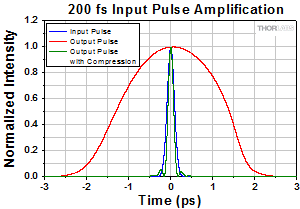

 Benchtop Ytterbium-Doped Fiber Amplifiers (YDFA)
Benchtop Ytterbium-Doped Fiber Amplifiers (YDFA)